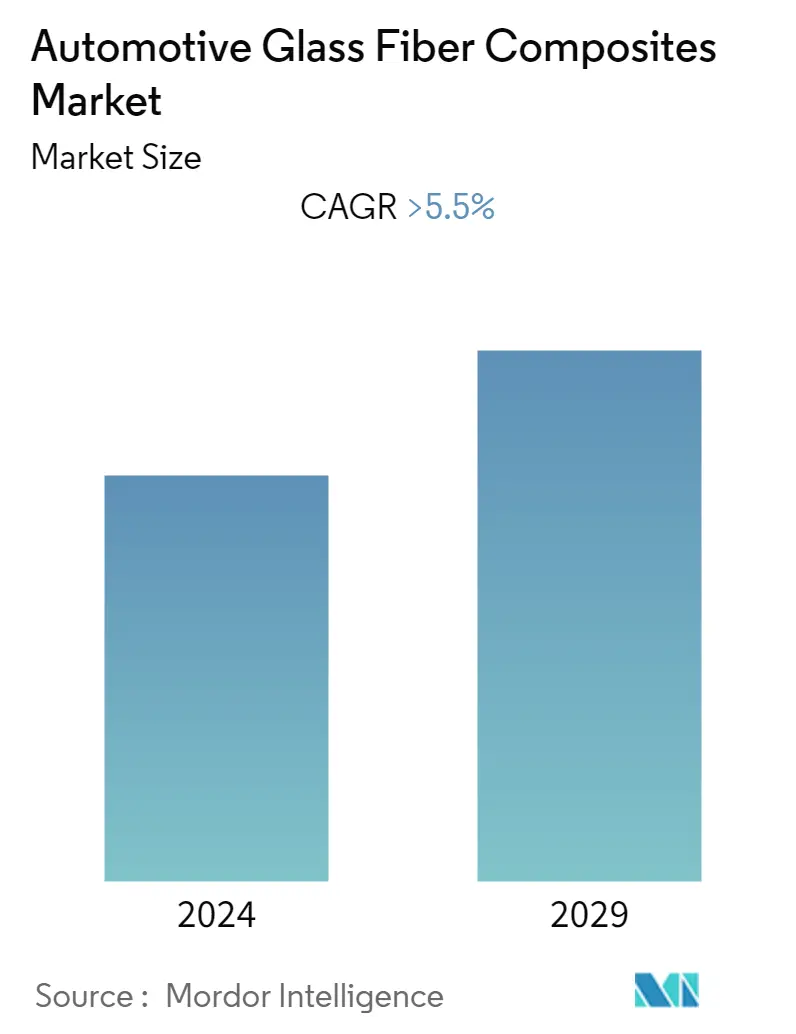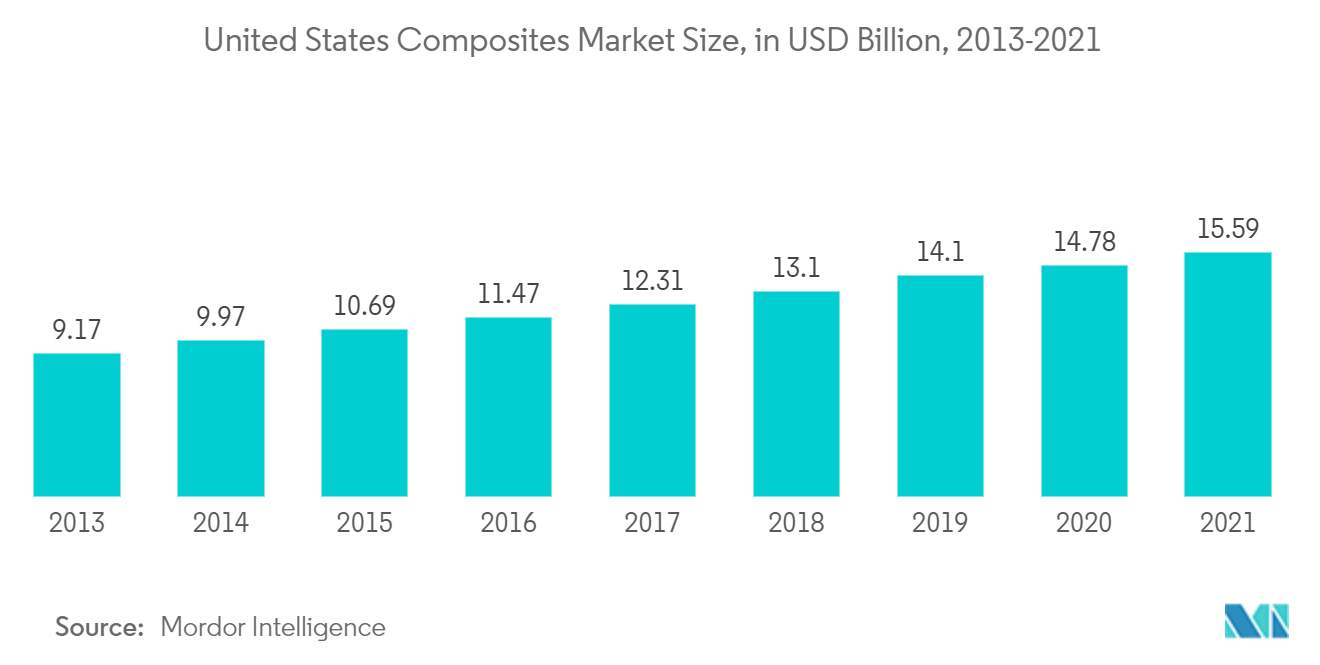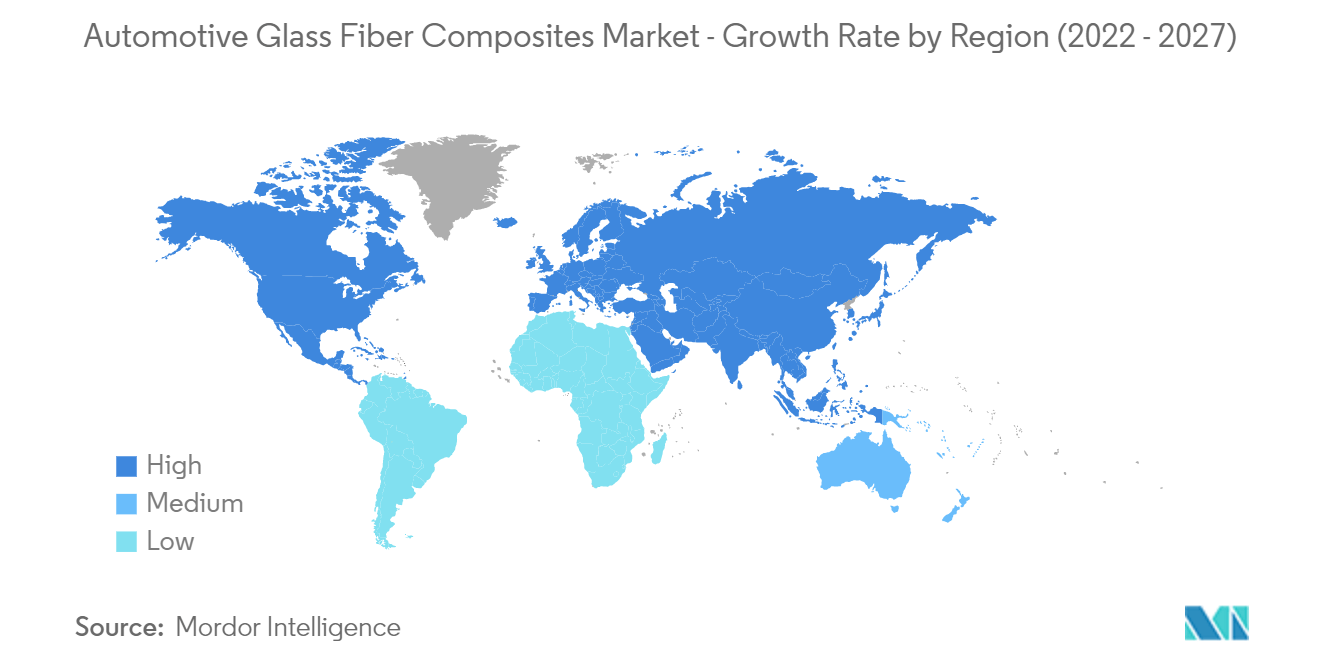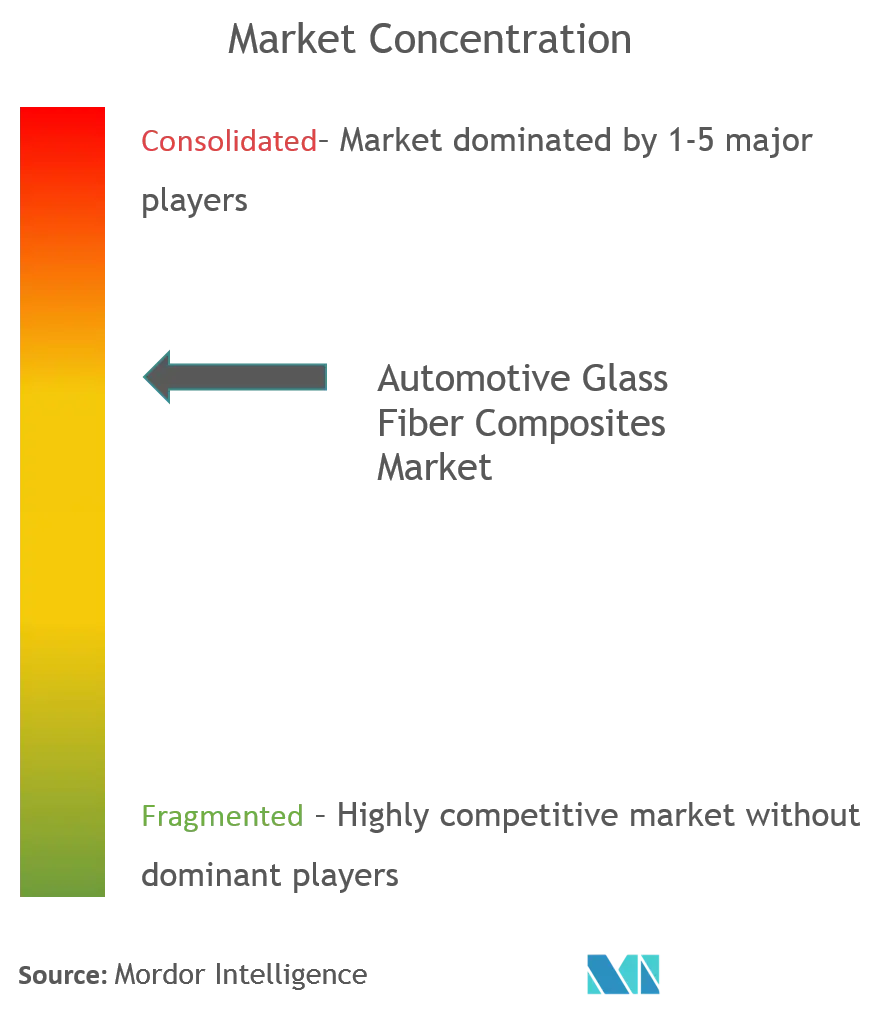Automotive Glass Fiber Composites Market Size

| Study Period | 2019 - 2029 |
| Base Year For Estimation | 2023 |
| CAGR | 5.50 % |
| Fastest Growing Market | Europe |
| Largest Market | Europe |
| Market Concentration | High |
Major Players
*Disclaimer: Major Players sorted in no particular order |
Automotive Glass Fiber Composites Market Analysis
The automotive glass fiber composites market is valued at USD 8 billion in 2021 and is expected to reach USD 11.03 billion by 2027, registering a CAGR of 5.5% during the forecast period 2022-2027.
- The COVID-19 pandemic has severely impacted the automotive industry across the world. The disruptions in supply chain activities, the interruption in large-scale manufacturing, restrictions on travel, and the declining sales of vehicles during 2020, are responsible for the declining growth of the market. However, the surge in the manufacturing volume of passenger cars and hybrid electric vehicles was observed globally after the pandemic due to the easing of restrictions in the country. The market will cope with all the losses during the period and grow at a certain pace.
- Over the long term, the major growth drivers associated with this market are the rise in automotive production and the increasing demand for durable and lightweight materials because of stringent government regulations to reduce greenhouse gas emissions.
- The future of the global automotive glass fiber composites market looks bright, with opportunities in different automobile applications, such as interiors, exteriors, structural assembly, power-train and engine components, electrical and electronics, and others. The market for glass fiber composites in automobile structures is expected to be the fastest-growing segment due to the wide variety of applications.
- Strategic alliances between car manufacturers, glass fiber, and resin suppliers are the trends that directly impact the dynamics of the automotive composites industry. Within the intermediates type, short fiber thermoplastic (SFT), long fiber thermoplastic (LFT), and continuous fiber thermoplastic (CFT) are the major ones that are used in automotive applications. SFT is expected to be the largest market by value, mainly driven by power-train and engine components applications, which feature small complex-shaped components.
Automotive Glass Fiber Composites Market Trends
This section covers the major market trends shaping the Automotive Glass Fiber Composites Market according to our research experts:
Increasing Adoption of Glass Fiber Composites in Automobiles
- Although automobiles have been around for over a century, their materials have mostly remained the same. Only in the past few decades that advanced materials, ranging from magnesium alloys to glass fibre composites, made their way into new-generation cars.
- The lightweight, cost, sustainability, and crashworthiness of vehicles can all be significantly improved by using novel composite variants. Composite materials reduce the weight of a vehicle component, resulting in improved fuel economy and lower emissions. Due to their superior mechanical properties, composite materials outperform conventional ones in terms of safety, comfort, and vehicle performance.
- Advanced materials, such as glass fibre composites, are essential for boosting the fuel economy of modern cars and maintaining performance and safety. Since it takes lesser energy to accelerate a lighter object than a heavier one, lightweight materials offer great potential for increasing vehicle efficiency. A 10% reduction in the vehicle's weight can transpire to a 6-8% increase in fuel economy.
- Glass fiber composites have become popular in the past few years. One of the reasons for fiberglass composite's relative success is that it has several advantages when compared to steel. It is corrosion-resistant, has significant chemical resistance, and is lightweight (three times less dense than steel). Fiberglass composite is mainly used in bumpers, hoods, and casings.
- Another area where this material is used is V-belts and timing belts, where glass strings are impregnated with rubber acting as reinforcement. Abrasion resistance is one other advantage of the fiberglass composite, which is why it is used for producing clutches and brake pads. Clutch disks are reinforced with woven fiberglass composites to maintain their integrity.

Europe Anticipated to be the Largest and Fastest Growing Market
- Europe is touted to be the fastest growing market due to the presence of many car manufacturers, such as BMW, Volkswagen, Groupe PSA, etc., who are adopting glass fiber composites in their cars.
- For instance, Government regulations, such as the greenhouse gas emission target in European countries, are also paving the way for OEMs to incorporate lightweight materials to decrease the overall vehicle weight.
- Germany is one of the leading automobile-manufacturing countries globally. The country has recovered to a reasonable extent from the economic recession that affected the economic condition of the country adversely. Germany is home to leading global automobile manufacturers, like Volkswagen AG, Daimler AG, BMW, Ford GmbH, and Opel. More than 5.1 million automobiles are manufactured annually in Germany. With an increase in the production of passenger vehicles and SUVs, the demand for fiberglass in the reinforcements of automotive components is expected to increase significantly during the forecast period.

Automotive Glass Fiber Composites Industry Overview
The automotive glass fiber composites market is mildly consolidated. Some major glass fiber composites market companies include Solvay Group, 3B (Braj Binani Group), Owens Corning, Veplas Group, and SAERTEX GmbH & Co.KG. Major players' product innovations aid the market. For instance,
In June 2022, Teijin Limited (Teijin) announced that glass fiber sheet molding compound (GF-SMC) produced by Teijin Automotive Technologies (TAT), a Teijin subsidiary in the United States, has been chosen for the pickup box of the 2022 Toyota Tundra Pickup truck for the North American market. TAT's plant in Seguin, Texas, manufactures the pickup boxes. The GF-SMC is a molding material composed of a sheet of glass fiber impregnated with a thermosetting resin. TAT's proprietary composite formulation and molding technologies are used to press-mold the Tundra pickup box in one piece.
Automotive Glass Fiber Composites Market Leaders
-
3B (Braj Binani Group)
-
Owens Corning
-
Solvay Group
-
Veplas Group
-
SAERTEX GmbH & Co.KG
*Disclaimer: Major Players sorted in no particular order

Automotive Glass Fiber Composites Market News
- November 2022: Solvay and Orbia announced a framework agreement for a joint venture to produce battery materials creating the largest capacity in North America. The total investment is estimated to be around USD 850 million, partially funded by a USD 178 million grant from the US Department of Energy to Solvay to build a facility in Augusta, Georgia. Solvay and Orbia intend to use two production sites in the southeastern United States, one for raw materials and the other for finished goods. Both plants will be fully operational by 2026.
- October 2022: Solvay has introduced the SolvaLite SF200 surfacing film, a light tack film for paintable 'Class A' body panels. From October 17 to 20, 2022, the new product was officially introduced at the Composite and Advanced Materials Expo (CAMX) in Anaheim, California. SolvaLite SF200 is designed for large body panels on premium sports and other high-end vehicles. It is an addition to Solvay's new SolvaLite 714 Prepregs, which are available in various unidirectional carbon fiber reinforced and woven-fabric formats for automotive and high-volume press-cure applications.
- February 2022: Teijin Automotive Technologies announced the commencement of commercial operation of its new manufacturing facility in Wujin National Hi-Tech Industrial Zone, China. The company also unveiled the construction of its third plant in China, in Shenyang, to cater to the surging demand for electric vehicles.
Automotive Glass Fiber Composites Market Report - Table of Contents
1. INTRODUCTION
- 1.1 Study Assumptions
- 1.2 Scope of the Study
2. RESEARCH METHODOLOGY
3. EXECUTIVE SUMMARY
4. MARKET DYNAMICS
- 4.1 Market Drivers
- 4.2 Market Restraints
-
4.3 Industry Attractiveness - Porter's Five Forces Analysis
- 4.3.1 Threat of New Entrants
- 4.3.2 Bargaining Power of Buyers/Consumers
- 4.3.3 Bargaining Power of Suppliers
- 4.3.4 Threat of Substitute Products
- 4.3.5 Intensity of Competitive Rivalry
5. MARKET SEGMENTATION ( Value in USD Billion/Million)
-
5.1 Intermediate Type
- 5.1.1 Short Fiber Thermoplastic (SFT)
- 5.1.2 Long Fiber Thermoplastic (LFT)
- 5.1.3 Continuous Fiber Thermoplastic (CFT)
- 5.1.4 Other Intermediate Types
-
5.2 Application
- 5.2.1 Interiors
- 5.2.2 Exteriors
- 5.2.3 Structural Assembly
- 5.2.4 Power-train Components
- 5.2.5 Others
-
5.3 Geography
- 5.3.1 North America
- 5.3.1.1 United States
- 5.3.1.2 Canada
- 5.3.1.3 Rest of North America
- 5.3.2 Europe
- 5.3.2.1 Germany
- 5.3.2.2 United Kingdom
- 5.3.2.3 France
- 5.3.2.4 Rest of Europe
- 5.3.3 Asia-Pacific
- 5.3.3.1 China
- 5.3.3.2 Japan
- 5.3.3.3 India
- 5.3.3.4 Rest of Asia-Pacific
- 5.3.4 South America
- 5.3.4.1 Brazil
- 5.3.4.2 Rest of South America
- 5.3.5 Middle-East and Africa
- 5.3.5.1 United Arab Emirates
- 5.3.5.2 South Africa
- 5.3.5.3 Rest of Middle-East and Africa
6. COMPETITIVE LANDSCAPE
- 6.1 Vendor Market Share
-
6.2 Company Profiles
- 6.2.1 Solvay Group
- 6.2.2 3B (Braj Binani Group)
- 6.2.3 Owens Corning
- 6.2.4 Jiangsu Changhai Composite Materials
- 6.2.5 Veplas Group
- 6.2.6 SAERTEX GmbH & Co.KG
- 6.2.7 ASAHI FIBER GLASS Co., Ltd.
- 6.2.8 Nippon Sheet Glass Company, Limited
- *List Not Exhaustive
7. MARKET OPPORTUNITIES AND FUTURE TRENDS
** Subject To AvailablityAutomotive Glass Fiber Composites Industry Segmentation
Glass-fiber composite is a type of fiber-reinforced polymer composite. Glass-fiber composite holds good properties such as low density, high strength, and easy processing, so widely used in automotive applications for increased fuel efficiency with reduced emissions.
The automotive glass fiber composites market has been segmented by intermediate type (short fiber thermoplastic (SFT), long fiber thermoplastic (LFT), continuous fiber thermoplastic (CFT), and other intermediate types), application (interior, exterior, structural assembly, power-train components, and others), and geography (North America, Europe, Asia-Pacific, South America, Middle East and Africa).
The report offers the market size in value (USD Billion) and forecasts for all the above segments.
| Intermediate Type | Short Fiber Thermoplastic (SFT) | |
| Long Fiber Thermoplastic (LFT) | ||
| Continuous Fiber Thermoplastic (CFT) | ||
| Other Intermediate Types | ||
| Application | Interiors | |
| Exteriors | ||
| Structural Assembly | ||
| Power-train Components | ||
| Others | ||
| Geography | North America | United States |
| Canada | ||
| Rest of North America | ||
| Geography | Europe | Germany |
| United Kingdom | ||
| France | ||
| Rest of Europe | ||
| Geography | Asia-Pacific | China |
| Japan | ||
| India | ||
| Rest of Asia-Pacific | ||
| Geography | South America | Brazil |
| Rest of South America | ||
| Geography | Middle-East and Africa | United Arab Emirates |
| South Africa | ||
| Rest of Middle-East and Africa |
Automotive Glass Fiber Composites Market Research FAQs
What is the current Automotive Glass Fiber Composites Market size?
The Automotive Glass Fiber Composites Market is projected to register a CAGR of greater than 5.5% during the forecast period (2024-2029)
Who are the key players in Automotive Glass Fiber Composites Market?
3B (Braj Binani Group), Owens Corning, Solvay Group, Veplas Group and SAERTEX GmbH & Co.KG are the major companies operating in the Automotive Glass Fiber Composites Market.
Which is the fastest growing region in Automotive Glass Fiber Composites Market?
Europe is estimated to grow at the highest CAGR over the forecast period (2024-2029).
Which region has the biggest share in Automotive Glass Fiber Composites Market?
In 2024, the Europe accounts for the largest market share in Automotive Glass Fiber Composites Market.
What years does this Automotive Glass Fiber Composites Market cover?
The report covers the Automotive Glass Fiber Composites Market historical market size for years: 2019, 2020, 2021, 2022 and 2023. The report also forecasts the Automotive Glass Fiber Composites Market size for years: 2024, 2025, 2026, 2027, 2028 and 2029.
Automotive Glass Fiber Composites Industry Report
Statistics for the 2024 Automotive Glass Fiber Composites market share, size and revenue growth rate, created by Mordor Intelligence™ Industry Reports. Automotive Glass Fiber Composites analysis includes a market forecast outlook to 2029 and historical overview. Get a sample of this industry analysis as a free report PDF download.



